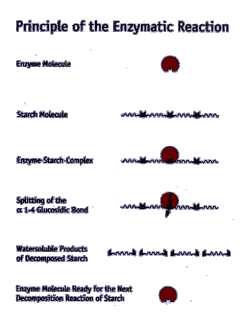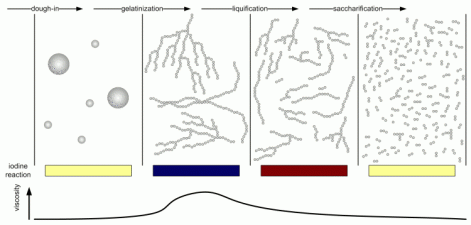Craft Distiller Education
Liquefaction
“The process of Liquefying”. More importantly to distillers, it is the process of breaking down the starch that became available through gelatinization, covered in this previous post. Once the starch is in solution as best that can be managed, we now begin the process of breaking the starch down into sugars. This is typically accomplished with an alpha-amylase enzyme, or with addition of malted grain which contains its own enzymes. The alpha-amylase enzyme cuts randomly along a long chain of starch to produce large and small sugars very quickly. This process can take anywhere from 30-120 minutes, depending on agitation, temperature, pH, and starch exposure to the water. Doing an iodine test for available starch is a very easy positive/negative test where the iodine will turn blue in the presence of starch, and will remain tan/yellow/brown if there is not starch present. Once the point of full conversion (no starch) has been reached, the next step of Saccharification can be taken. Saccharification is where the larger sugars are broken down into smaller, fermentable sugars. This topic will be covered further in its own post.
| General name | Source organism | Temp range (F) | pH range | Function |
| Low temp AA | Fungal | 70 – 140 F | 3 – 5 | Liq/Sac |
| Medium temp AA | Bacterial | 120 – 170 F | 4.5 – 7 | Liquefaction |
| High temp AA | Bacterial | 175 – 190 F | 5.6 – 6.5 | Liquefaction |
| Malted Barley AA | Plant | 148 – 167 F | 5.2 – 6.0 | Liquefaction |
Some notes here about the specific enzymes that are pertinent to liquefaction. Alpha-amylases come in 3 different types (at time of publishing) broken down by activity at certain temperature ranges: low, medium, and high temperature. It is good to take note of the origin of these enzymes, or what micro-organism they were sourced from, as that affects the enzyme tolerances.
Low temperature AA’s work in the 70-140 F range, they are useful for fruit mashes, or mashes that are acidic for some reason or another. This enzyme works slightly differently than bacterial alpha-amylases as it can also function for saccharification. Fungal alpha-amylase works a bit slower and over time will form significant amounts of maltose (45-55%), which can also make it useful to gluten free brewers trying to mimic malted barley enzyme profiles. Most uses for this enzyme are “no heat” methods for conversion of pre-modified starch, or assisting in fruit mashing/fermentation.
Medium temperature alpha-amylase has a working range of 120 – 170 F; it is best used for infusion mashing or medium temp conversions. This enzyme is the most widely available and cheapest of the 3 alpha-amylases. Most homebrew supply stores that supply “amylase” are actually stocking this enzyme. It is good for medium temperature conversions of grains that have lower gelatinization points (see gelatinization post), for example: raw rye, wheat, or barley could all be mashed within this temperature range with good results.
High temperature alpha-amylase works in the 175-190 F range (sometimes higher if stabilized by Calcium) which makes this enzyme the best amylase for cooking unmalted grains, or almost any starch source for simultaneous gelatinization and liquefaction. High heat plus good milling leads to excellent gelatinization, and fantastic liquefaction, which in turn gives some of the best yields. However the high cost of heating/cooling should be factored in as it is not the most time efficient way to mash when factoring in time constraints.
When using malted grain (usually barley), be mindful if it’s diastatic power as stated by the malt provider. Diastatic power is a measure of the enzymes in the malted barley so ask for/consult a technical sheet for more details on your malt. Depending on the diastatic strength of the malt, a distiller can use more or less malted barley to save money and still liquefy the starch. Generally, distillers will end up using 6-row or “distiller’s malt” for their high enzyme content, though other options are available as well. Either way, be mindful of the temperature of the mash, higher infusion temperatures (150-165 F) will favor the activation of the malted barley alpha-amylase which will leave more unfermentable sugar in solution. Lower infusion temperatures (135-150 F) will favor the activation of the beta-amylase, which will create more fermentable sugars like maltose. These two ranges are typically combined into the range of 148-154 F where both enzymes are being activated and a moderately fermentable mash can be achieved fairly quickly. Sometimes a grain bill can consist of 5% malted barley (Distillers malt), and that is enough to convert the other 95% of the mash when given enough time, just be mindful your pH and Temp.
 Enzymes are the only reason starch is converted to fermentable sugar in every distillery/brewery out there, if the starch is not converted, the yeast have nothing to feed on, and no alcohol is produced. Enzymes are delicate, pseudo living things, it is best to be mindful of their advertised restrictions by the enzyme provider. pH, temperature, concentration, agitation, and contact are all things to consider.
Enzymes are the only reason starch is converted to fermentable sugar in every distillery/brewery out there, if the starch is not converted, the yeast have nothing to feed on, and no alcohol is produced. Enzymes are delicate, pseudo living things, it is best to be mindful of their advertised restrictions by the enzyme provider. pH, temperature, concentration, agitation, and contact are all things to consider.
Cheers!
What do you think about enzymes? Would you be interested in learning more?